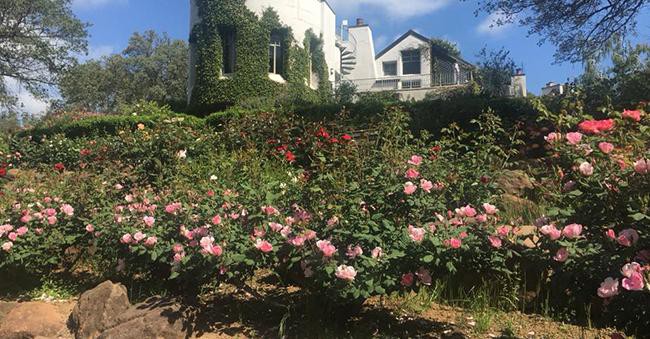
See Poswalls' Springhill near Lincoln and a hidden Newcastle oasis

Springhill, the gardens of John Poswall and Peg Tomlinson Poswall, will open for visitors Sunday. Courtesy Poswall Gardens
“If only I had room!” Every gardener has had that thought.
Here’s an opportunity to see two amazing and imaginative private gardens in Placer County created by folks who had enough room to let their dreams really grow. One garden – the Poswalls’ Springhill – sprawls over 50 oak-studded acres near Lincoln; the other – a 3-acre oasis outside Newcastle – has never been shared on a public tour.
Both gardens will welcome visitors from 10 a.m. to 4 p.m. Sunday, June 4, during The Garden Conservancy’s Open Garden Days. These two participating gardens are about 20 minutes apart.
Suggested donation is $10 per garden per person. Patrons may sign up for one garden or both, but advance registration is a must. Sign up here.
The Garden Conservancy’s Open Garden Days program “annually celebrates the country’s most exciting, creative, and innovative private gardens,” says the conservancy. “Open Days is made up of a nationwide community of gardeners and garden enthusiasts teaching and inspiring each other and the public. From expert to novice, there is no better way to improve as a gardener than by experiencing a diverse range of gardens, and gardening traditions, firsthand.”
These two Placer County gardens are excellent examples.
Created by novelist/attorney John Poswall and his wife, food expert Peg Tomlinson Poswall, Springhill is not one garden but more than 20. It’s a rare collection of whimsy inspired by the couple’s world travels, complete with its own Stonehenge.
“Start at the Chinese Garden, hidden away below levies, with its Hidden Buddha Garden, Xi'An warrior, and Lotus Pond, and exit at waterfalls,” suggest the organizers. “Walk the plant-covered Islamic arched pergola to the Mexican Garden with its palapa and palms, and then on to the 400-foot-long Statuary Garden lined with Italian cypress; St. Michael at the top, the Three Graces at the bottom, and a 19-foot-high fountain in between. Above is the Italian Garden and still higher the Rose Garden with a view of the house and tower.”
In between are cactus and drought-tolerant gardens as well as lotus-filled ponds and shady retreats. Wear comfortable shoes.
The second stop is also special. Nicknamed Cheryl’s Oasis, this 3-acre private garden has been 47 years in the making. Located off Highway 193, just west of Newcastle, the property features a series of garden “rooms”; at the center is a screened-in sleeping room – open to nature. A highlight is the gardener’s vast collection of succulents, grown for three decades.
“More than 100 species and varieties of plants, flowering bushes, and trees surround the home with a mixed feeling of cactus, ferns, bamboo, and yucca crowding pathways lined with succulents, agave, and aloe,” say the organizers. “Pine trees and fruit trees sit alongside Chinese fringe and tulip trees with red canna below. … All this, in a distinct sense of quiet and peace.”
See for yourself – but one day only.
For more details: https://www.gardenconservancy.org/
Comments
0 comments have been posted.Sacramento Digs Gardening to your inbox.
Food in My Back Yard Series
May 6: Maintain soil moisture with mulch for garden success
April 29: What's (already) wrong with my tomato plants?
April 22: Should you stock up on fertilizer? (Yes!)
April 15: Grow culinary herbs in containers
April 8: When to plant summer vegetables
April 1: Don't be fooled by these garden myths
March 25: Fertilizer tips: How to 'feed' your vegetables for healthy growth
March 18: Time to give vegetable seedlings some more space
March 11: Ways to win the fight against weeds
March 4: Potatoes from the garden
Feb. 25: Plant a fruit tree now -- for later
Feb. 18: How to squeeze more food into less space
Feb. 11: When to plant? Consider staggering your transplants
Feb. 4: Starting in seed starting
Sites We Like
Garden Checklist for week of May 11
Make the most of the lower temperatures early in the week. We’ll be back in the 80s by Thursday.
* Plant, plant, plant! It’s prime planting season in the Sacramento area. Time to set out those tomato transplants along with peppers and eggplants. Pinch off any flowers on new transplants to make them concentrate on establishing roots instead of setting premature fruit.
* Direct-seed melons, cucumbers, summer squash, corn, radishes, pumpkins and annual herbs such as basil.
* Harvest cabbage, lettuce, peas and green onions.
* In the flower garden, direct-seed sunflowers, cosmos, salvia, zinnias, marigolds, celosia and asters. (You also can transplant seedlings for many of the same flowers.)
* Plant dahlia tubers.
* Transplant petunias, marigolds and perennial flowers such as astilbe, columbine, coneflowers, coreopsis, dahlias, rudbeckia and verbena.
* Keep an eye out for slugs, snails, earwigs and aphids that want to dine on tender new growth.
* Feed summer bloomers with a balanced fertilizer.
* For continued bloom, cut off spent flowers on roses as well as other flowering plants.
* Add mulch to the garden to maintain moisture. Mulch also cuts down on weeds. But don’t let it mound around the stems or trunks of trees or shrubs. Leave about a 6-inch-to-1-foot circle to avoid crown rot or other problems.
* Remember to weed! Pull those nasties before they set seed.
* Water early in the day and keep seedlings evenly moist.